Preserving Traditional Knowledge, Enhancing Livelihoods, and Conserving Biodiversity in Baramulla, Jammu & Kashmir
In the Baramulla & Gurez valleys of Jammu and Kashmir, our initiative is dedicated to mapping and preserving the rich local bioresources, traditional knowledge systems, and grassroots innovations. Both regions are home to a diverse range of flora and fauna and a wealth of indigenous knowledge passed down through generations. Our mission is to empower local communities, particularly women, by leveraging their traditional knowledge of medicinal plants, wild edible herbs, and sustainable agricultural practices. Through carefully designed activities, we created sustainable livelihoods, conserve biodiversity, and promote rural development in collaboration with other stakeholders.
At the heart of our project are community-led activities that drive tangible outcomes. We begin with participatory biodiversity mapping, where local communities actively participate in scouting & documentation of local traditional knowledge and the region’s flora and fauna through workshops and field surveys. This creates a comprehensive database as the foundation for conservation and sustainable use. We conduct skill development and capacity-building sessions to empower women and farmers focused on sustainable harvesting, value addition, and entrepreneurship. These activities equip participants with the knowledge and tools to generate income through eco-friendly practices and small-scale enterprises. Additionally, we collaborate with research institutions to scientifically validate the efficacy of medicinal plants and traditional remedies, enhancing the credibility and market potential of local products.
Promoting sustainable farming practices is another key focus area. We organize workshops on organic farming, crop diversification, and soil conservation, which lead to improved agricultural productivity, reduced environmental impact, and strengthened food security. To ensure economic sustainability, we support SHGs and FPOs in developing market-ready products from wild edibles and medicinal plants while connecting them with buyers. This creates sustainable livelihoods, increases income, and fosters economic independence. Finally, we conduct awareness campaigns to educate communities on biodiversity conservation, the importance of traditional knowledge, and sustainable practices, fostering a sense of ownership and commitment to preserving their natural and cultural heritage.
We aim to achieve transformative outcomes through these activities, including empowering women and marginalised groups, preserving biodiversity and traditional knowledge, and strengthening community resilience and self-reliance. By fostering collaboration between local communities, researchers, and market players, we are working towards a sustainable future rooted in the rich traditions and natural wealth of the region. Together, we can create a lasting impact and ensure that the unique heritage of Jammu and Kashmir is preserved for generations to come.
Our Approach:
- Community Engagement: Identifying and documenting traditional practices.
- Research & Development: Collaborating with institutions to validate and enhance traditional knowledge.
- Sustainable Practices: Promoting natural farming practices and biodiversity conservation.
Our Work
Documentation of Traditional Knowledge:
- Conducted over 90 community meetings across 20 villages.
- Collected and documented 450 plant specimens and 1000 traditional uses.
A survey of 99 households was conducted.
Baseline Survey results
- Construction of the Houses: The majority are living in the Pakka House (85.86%), less number are living in the Kachcha (14.14%) houses.
- Types of Mode Vehicle: The majority of respondents (80.81%) do not own a vehicle. Among owners, 2.02% have cars, 3.03% have two-wheelers, and 11.11% own either. A small fraction (1.01%) own a car, bike, or a mix of cycle and two-wheeler. Mobility constraints keep market exchanges largely local, but the project has introduced community members to opportunities in distant markets.
- Occupation and Income Distribution: The majority of community members earn a monthly income from services, labor, agriculture, and skilled trades, with the most common income being less than 10K. Bridging the gap between the better-off and the rest is essential.
- Occupational Distribution: The majority of the marginal farmers having less than one acre land depended upon artisanal activities and labour, while those with one to two acre land relied more on agricultural activities.
- Cultivation of Crops: Maize is the predominant crop, accounting for 28.15% of total cultivation. Beans (9.26%) and other pulses (20.37%) also form a significant share. Apple is the main horticultural crop, while various vegetables receive substantial attention from farmers.
- Exploring the Wild: Foraging Herbs from Roadsides, Farm Borders, and Weeds Edible greens and herbs make up 59.88% of herbal collections, including wild plants gathered for culinary and medicinal use. The remaining 40.12% consists of non-edible plants and mushrooms, valued for medicinal, ornamental, or other purposes like crafting. The widespread collection of herbs highlights the community’s deep ecological knowledge, which could drive bioentrepreneurship. Recognizing the diverse uses of these plants is essential for effective learning and innovation.
- Family Recipes: Celebrating Special Occasions and Everyday Delights Traditional family recipes reflect cultural and seasonal influences. About 8.4% of community members mention winter recipes using dried vegetables, while 2.52% associate specific dishes with occasions like Marriage and Muharram/Ashura. Kashmiri Wazwan, a prized dish, is noted by 3.36%, indicating its limited affordability. However, 21.01% had no specific knowledge to share, suggesting possible knowledge erosion. Overall, Kashmiri cuisine is diverse, shaped by traditions, seasons, and cultural norms.
- Preserving and Storing Vegetables and Fruits: Vegetable preservation is the most common practice (31.66%), driven by prolonged winters. Leafy greens, often foraged, are preserved by 14.73%, while fruits (9.09%) are stored for extended use. Wild plant preservation (16.61%) underscores traditional knowledge in nutrition and medicine. With flourishing horticulture, there is significant potential for value addition. Overall, food preservation supports seasonal availability, culinary needs, and resource conservation.
- Category of plants used to treat human ailments (wound, pain, pre/ post-delivery, old people/children/women/cosmetics, industrial use (colouring clay vessel or any other such use): Traditional knowledge of plants is largely tied to ‘Other Items’ (70.93%), including roots, bark, and leaves used for medicine, cosmetics, and industrial applications. Herbs and whole plants account for 20.35%, while fruits and seeds make up 8.72%, highlighting diverse plant-based practices.
- Traditional Knowledge-Animal (feed/fodder/veterinary medicine, any other uses): Mustard (Brassica nigra) is the most commonly referenced plant in traditional knowledge, primarily for animal medicine. Taree Gassi follows at 2.27%, while other plants play a lesser role in veterinary care and animal nutrition.
- Traditional Knowledge Animal feed Plant Production: Feed and fodder usage varies across plant types. Mustard (Brassica nigra), Dudije Dramun Maize grass, and Kaw Ashud are used at 6.98% for 1kg. ‘Three Gassi’ is specifically used at 3kg/day (100%), while Khaseel and Maine grass (Zea) range from 4-5kg. The data reflects diverse usage and dosage in traditional herbal practices.
- Traditional Knowledge Agriculture (herbal pesticide, growth promoter, weedicide, or any other): Plants like Keam Neer (Stellaria media), Kreheen Koth (Saussurea lappa), Pine leaves, and Tethwan (Artemisia) are widely foraged from the wild or field borders. Pine leaves and Artemisia are key in herbal pesticides, growth promoters, and weedicides. Pine leaves are mainly collected in autumn (66.67%) and summer-autumn (33.33%), while Tethwan-related activities peak in mid-summer (57.14%) and spring-autumn (42.86%).
- Entrepreneurial Aspirations: A significant percentage (67.35%) of respondents prefer setting up group enterprises to process and market biodiversity-based products, while a smaller percentage (3.06%) opts for individual enterprises. Additionally, 28.57% of respondents express interest in entrepreneurial initiatives without specifying individual or group basis. Only 1.02% of respondents indicate that they do not wish to set up such enterprises.
- Convenient Shipping Services: Packing and Sending by Post: A majority of respondents (96.91%) are willing to pack and send biodiversity-based products by post.
- Total Agricultural Output: As expected, communities primarily market walnuts, apples, maize, and red rajma.
- On-Farm Validation and Value Addition:
- Collaborated with SHGs and farmers to validate the use of indigenous bio-resources.
- Developed value-added products from forest & Horticulture produce.
- Established community storage godowns, processing centres, and central storehouses.
- Capacity Building and Skill Development:
- Trained over 150 women farmers in food processing, product development, and marketing.
- Organised workshops, exposure trips, and sustainable agriculture and entrepreneurship training programs.
- Biodiversity Conservation:
- Promoted sustainable harvesting practices to protect local ecosystems. Created a plant database (Master copy of J&K Bioresources Data).
- On-Farm Validation and Value Addition:
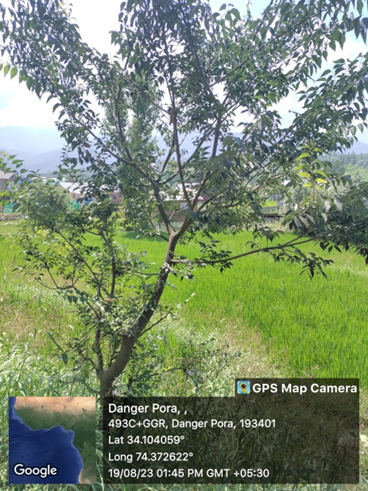
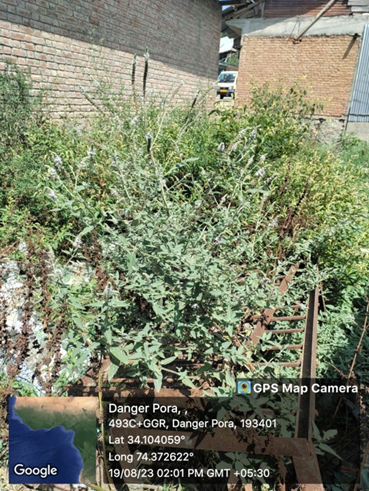
Figure 1. Geotagged photos of A. Celtis australis L., B. Mentha longifolia L
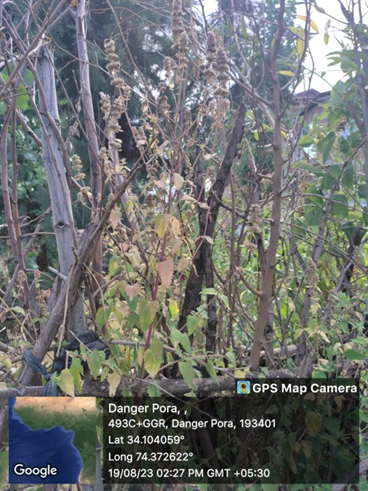
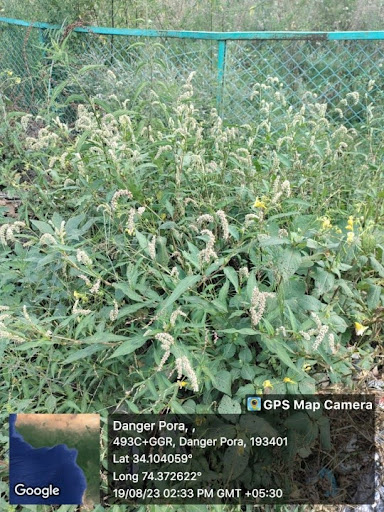
Figure 2. C. Nepeta cataria L. D. Persicaria maculosa
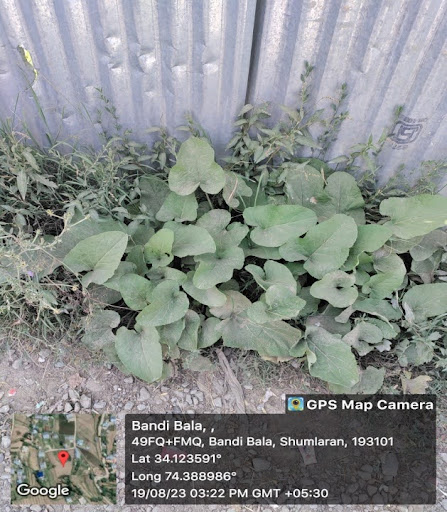
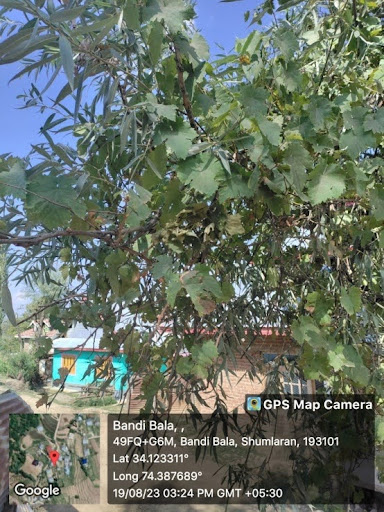
Figure 3. E. Arctium lappa L., F. Vitis vinifera L
- Setting Up Enterprises: Established eight enterprises based on Himalayan bio-resources, creating livelihood opportunities for rural women.
Impact
Our project has made a significant impact on the lives of rural communities in Baramulla:
- Livelihood Enhancement: Increased per capita income of SHG members.
- Skill Development: Trained over 150 women in food processing, product development, and marketing.
- Biodiversity Conservation: Promoted sustainable practices to protect local ecosystems and revive indigenous crops.
- Social Empowerment: Increased women’s participation in decision-making and community development activities.
Testimonials:
- Jabeena Bano, T.Y Shah Village: “This project has given me the confidence to start my own business and sell my herbal products in markets I never dreamed of visiting.”
- Ishrat Bano, Bandibala Village: “The training and support from this initiative have transformed my life and given me hope for a better future.”
- Shaheena Akther (Gurez): “This project has empowered me to become an entrepreneur and contribute to my family’s income.”

